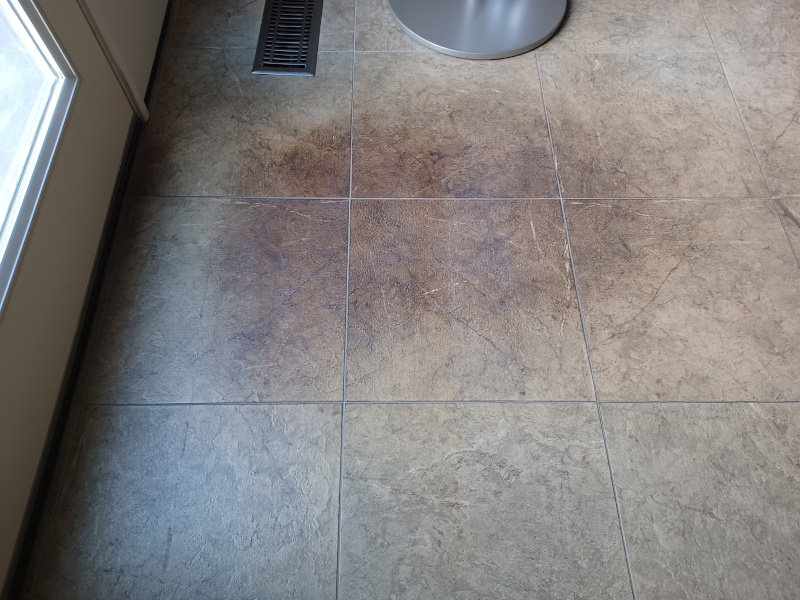Armstrong Alterna Floor Tiles, and the Sun
In 2012, we did remodeled our kitchen and neighboring rooms. Part of the work was to replace the existing flooring with Armstrong Alterna vinyl floor tiles, specifically the Taupe Gray D4135 pattern. The effects of sunlight on the tiles can be seen in a few images.
These two images were taken in 2023, in areas that get no direct sunlight. I took a leftover floor tile, which had been sitting in the original box in the garage for eleven years, and placed it squarely on top of an existing tile. As you can see, a decade of wear has had some effect but nothing dramatic.
 |
 |
| Hallway | Bathroom Entry |
As part of the remodel, we replaced a sliding-glass door with a swinging door. It turns out the glass in the door has no UV protection. It faces west, and we live in California, so for eleven years it got blasted by the afternoon sun. The results are pretty plain.
 |
 |
| Severely Faded | Scorched? |
The photo on the left clearly shows the color difference, and you can see an area to the left that looks almost scorched. The photo on the right shows it more clearly. The discolored area is not the result of a chemical spill or a space heater run amok. Over time, heat and UV light from the sun have scorched the vinyl.
The fading is generally not noticeable when looking at the room, because it transitions smoothly. It's only when you move something that has been in one place for a long time, or you put a pristine tile next to a faded one, that the change becomes obvious. The burnt area is on a whole other level though.
The specific style of tile is no longer in production. We have a dozen or so left over from the original project, so we could replace the burnt tiles, but there's a problem: all of the tiles nearby are so faded that the new tiles would look like a completely different model. We're going to add a layer of film to the window that blocks most UV and some heat (Ceramic 55 SR PS), which will help prevent further damage, but also means that the replacement tiles won't fade to look like the original ones over time.
So our options are:
- Replace the burnt tiles with pristine new ones, and just deal with the weird appearance.
- Leave the new tiles in the sun for a while and see if they'll age to the point where they look less weird, then do the replacement.
- Replace the floor tiles with something completely new, in a small area. The shape of the room doesn't really work with that concept.
- Replace all of the floor tiles with something new. They're on most of the ground floor, so that's a non-trivial exercise.
- Use a door mat to cover some of it.
Currently using option #5.
2024 update: while doing some remodeling in the kitchen and family room, the workers hung plastic sheets and taped the bottom edge to the floor to limit the spread of dust. When the tape got pulled up in the scorched area, it took the top layer of the floor up with it. This seemed like it was just going to get worse over time, so we had no choice but to replace it.
We ended up replacing the floor with "luxury vinyl planks" (Provenza Stonescape Cliff Hanger). This took most of a week for a crew of three, but we're happy with the results.
![[fadden-logo]](../images/faddenlogo.gif)